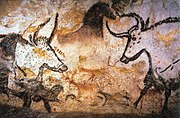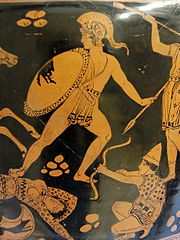Prehistory of art

Grotte de Lascaux
If one believes that art is to build, carve, to make ornaments, the existence of a prehistoric art seems indisputable. However, if we see in art a kind of luxury for museums and exhibitions, it is likely that early people may have never thought Finally, if we consider, more generally, that art is to speak to the senses and emotions of those who are the spectators, it is difficult not to classify artists authors of a number Production prehistoric, like the famous frescoes in the caves of Lascaux.
What was the exact function of sculptures and paintings made by these artists? We do not know with certainty, although the operating assumption ritual, magic, symbolic or of education have often been considered. The work of the artist would have probably been first described as an effective "practical" without ruling out some research aesthetics.
Africa

Illustration of African arts in the Swedish encyclopedia Nordisk familjebok
Africa has a host of local arts that reflect a variety of cultures that continue to evolve over time. These creations have been viewed as objects of art mostly from the early twentieth century, particularly under the influence of painters Cubist. The discovery of this art then significantly influenced the art modern Western
Today, most African works belong to private collectors because in the past, museums have neglected this art. Since then, ratings for authentic antiques have flown and the UNESCO has come to ban since the early 1990s the export of masks and statues outside Africa
The wooden mask, which is most often a spirit has long been regarded as the typical object that symbolized the best African art. But gradually other forms have come to light and in 1966 took place the first World Festival of Negro Arts in Dakar, with the world the richness of African art, with artists like Ousman Sow, N'Noye Assane, Paul Ahyi or Ashira Olatunde
Since 1989, a biennial of contemporary African art is held regularly in Dakar
Asia

Angkor Wat
The example of the Asian continent shows the difficulties of establishing classifications of art history based on continents and historical periods.
How to submit a consistency across such a broad and as diverse as that which meets:
religious contexts: the Buddhist art, the Arts of Islam
geographical groupings: the Chinese Art, the Art of Japan, the Tibetan art, the Indian art, the Persian Art
and more ...
And besides, the arts of Islam, are they not as African? The Buddhist art is not nowadays also produced in Europe?
America

Colossal Head San Lorenzo
The culture Olmec, between 1200 BC. BC and 500 BC. AD, the first great civilizations of Mesoamerica, is particularly known for its rich iconography and technical quality of his art, which was a landmark and a legacy for all crops later. The Olmec art is manifested by a great master of sculpture and carving. The artists Olmec were developing their art in the clay, the stone and wood and a few paintings rock.
The Mayan art developed during the Preclassic period (1500 BC to 250 AD -. C) during the Period I and II. He received the influences of civilization Olmec. Other civilizations Mesoamerica, including Teotihuacan and the Toltecs, affected to the and reached its peak during the period of classical civilization or Period III (around 200 to 900 AD). The Mayans are famous for their use of jade, of the obsidian and stucco.
The Aztec craftsmen (1300-1519) excelled in the art of stone mask, inherited from the Toltecs, whom they had a funeral or religious use. They wore paint the walls of their temples and their palaces.
The Native American Art is the art form native of North America. None of the indigenous languages of North America has, apparently he word corresponding to the Western concept of art. However, the objects created by the artisans are now considered works of art in itself.
Europe
Antiquity
Although it is geographically situated in Africa, the Art of Ancient Egypt, born there about five thousand years, is one of the main sources of art in Europe. It combines strict geometric regularity and keen observation of nature. His works were not intended to be admired by the living. They were placed in tombs of kings, then gradually in those characters of minor social importance to assist the souls of the dead to stay alive

Detail of a crater, V century BC. AD
But European art also owes much to the art of ancient Greece. In its early days, around the tenth century BC. AD, it is extremely simple and geometric. Subsequently, he draws CONSERE rules established by Egyptian art, including painting and sculpture.
Around the sixth century BC. BC occurred a revolution in Art: Artists beginning to overcome the rules of Egyptian art, which required to represent each part of a package (of a human body for example) in his corner more be recognized, sometimes at positions improbable of all. Freeing of these rules, they can represent a foot face or hide one arm on a character represented in profile: their paintings and sculptures become less stereotypical and more natural
By the late sixth century BC. BC, Greek artists are always simple mechanics, but a public becoming more interested in their works. Comparing the merits of different schools of art, masters of different cities. Some of them, as Praxiteles become extremely famous. A little later comes another trend: while none of the artists were trying to avoid giving their faces too precise a phrase, it begins to express their feelings and the reign of Alexander the Great saw the emergence of an art of portrait that the art of ancient Rome take up and develop more.